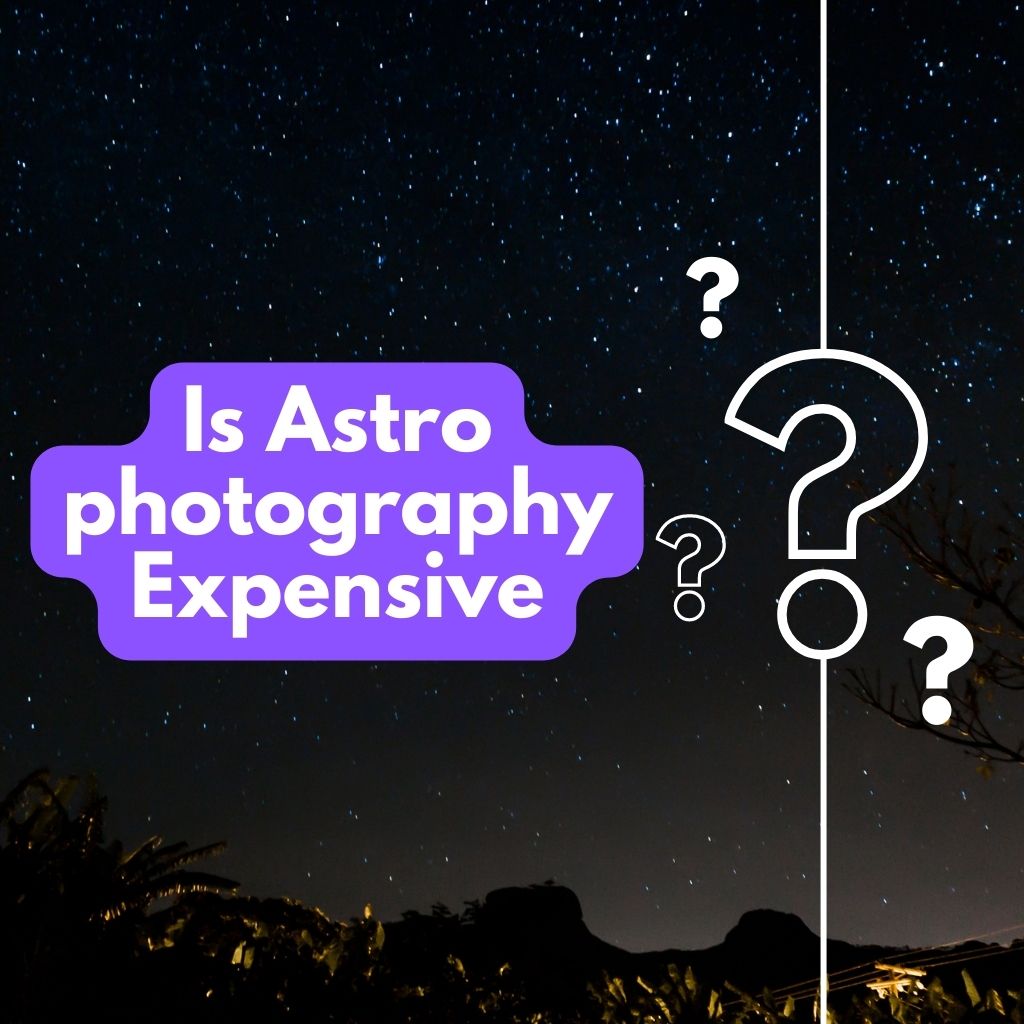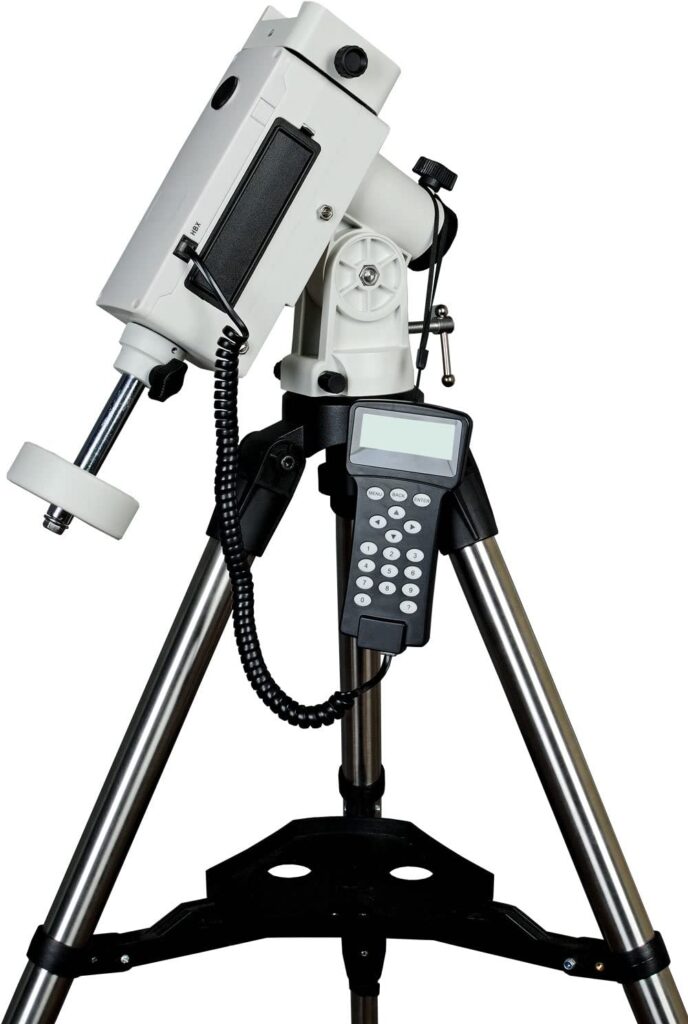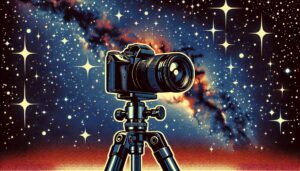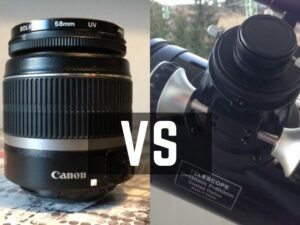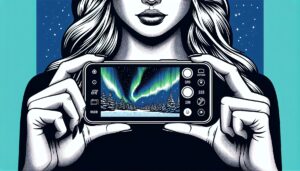This site contains affiliate links to products. I may receive a commission for purchases made through these links.
Astrophotography can be expensive due to the high costs typically associated with the specialized equipment. However, there are ways to capture beautiful images of the night sky without overspending. Carefully selecting the right setup and equipment will help you enjoy this hobby without breaking the bank.
Many people assume that astrophotography is expensive and requires high-end equipment. While it does require a significant investment, it’s not always an expensive hobby.
In this blog post, we’ll take a closer look at the cost of astrophotography and show you how to create a budget astrophotography setup.
What is the cost of astrophotography?
The cost of astrophotography varies greatly depending on the type and quality of equipment you choose and your level of expertise. A basic astrophotography setup can cost anywhere between $1200-$1500, while more advanced setups can cost anywhere from $3000.
The allure of deep sky astrophotography lies in its ability to reveal the hidden beauty of the cosmos, allowing us to glimpse distant galaxies, nebulas, and stars in unprecedented detail in the night sky.
However, the cost of getting started in astrophotography can be a barrier for many enthusiasts.
What factors influence the cost of astrophotography?
Here are some things that influence the cost of astrophotography.
Lenses and telescopes for observing the night sky
Lenses and telescopes are typically the most expensive components of an astrophotography setup. The size and quality of the lens or telescope you choose will significantly impact the cost.
Large aperture telescopes are more expensive, but they allow you to capture fainter objects in the night sky.
Similarly, lenses with a wide aperture are more expensive, but they allow more light into the camera, enabling you to capture brighter and sharper images.
You may also like: How Do Telescope Lenses Work? (Explained!)
Mounts for deep sky astrophotography
A stable mount is crucial for astrophotography, as it helps keep your camera or telescope steady during long exposures. More advanced mounts with features like auto-guiding can be quite expensive.
Auto-guiding is a technique that involves using a secondary camera to track the movement of the stars and adjust the mount accordingly, which is essential for capturing sharp and accurate images of the night sky.
Accessories for observing deep sky objects
There are a variety of accessories that can be used to enhance night sky photography. Filters are used to reduce light pollution and enhance the visibility of certain objects in the night sky.
Field flatteners and focal reducers are used to correct optical aberrations and improve the sharpness of the image.
These accessories can add to the overall cost of your setup, but they are essential for achieving high-quality results, while others, such as the star tracker, may be optional.
Observing session locations
The cost of astrophotography can also be influenced by the location where you shoot. If you live in a light-polluted area, you may need to travel to a dark sky site, which can add to your expenses.
Dark sky sites are areas with minimal light pollution, and they are ideal for capturing detailed images of the night sky.
Some astrophotographers invest in portable power sources and telescopes that can be easily transported to remote locations for the best viewing experience.
Level of expertise in astrophotography
The cost of astrophotography can also vary depending on your level of expertise. If you are just starting out, you may be able to get by with a more affordable setup. In contrast, experienced astrophotographers may require more advanced equipment to achieve the results they want.
As you gain more experience and knowledge, you may want to upgrade your equipment to achieve better results, which can add to the overall cost of your setup.
Cheapest astrophotography setup
If you’re looking for an affordable astrophotography setup, there are several options to choose from. However, it is important to bear in mind that the pricing of the products included in the setup is subject to alterations.
Here are some of the cheapest options available with some of the most affordable components for an astrophotography setup.
Cheapest telescope for astrophotography
The Sky-Watcher EvoStar 72 APO Doublet Refractor is an affordable telescope for astrophotography going for about $500-600. It features a 72mm aperture and a doublet lens design that helps minimize chromatic aberration, resulting in clear and sharp images.
The telescope also comes with a sturdy and adjustable mount, allowing for precise and stable tracking of celestial objects.
The Sky-Watcher EvoStar 72 APO is compatible with a variety of cameras, including DSLRs and CCDs, and features a retractable dew shield to prevent moisture buildup on the lens.
Cheapest astrophotography cameras
If you’re looking for an affordable camera for astrophotography, DSLR cameras are good options. The Canon EOS Rebel T7 and Nikon D3500 are both great choices and can be used with a telescope and T-ring adapter to capture images of the Moon, planets, and some deep-sky objects. They cost around $400-$500 and offer good image quality for the price.
The Canon EOS Rebel T7 is an entry-level DSLR camera released in 2018 that is ideal for astrophotography enthusiasts.
Its low-light performance with a maximum ISO of 12800, long exposure noise reduction feature, and Live View mode make it a great camera for capturing clear, detailed images of stars and other celestial objects in the night sky.
Its compatibility with a wide range of lenses, including Canon’s EF and EF-S lenses, gives users a lot of flexibility in terms of focal length and aperture.
The Nikon D3500 is another affordable entry-level DSLR camera that offers excellent low-light performance and a range of features that make it a great option for astrophotography.
Its high ISO range, long exposure noise reduction feature, Guide Mode, and lightweight and compact design make it user-friendly and versatile for capturing images of the night sky.
You may also like: Budget Astrophotography With a Telescope and DSLR Camera
Cheapest mount for astrophotography
The iOptron SmartEQ Pro+ EQ Mount is a good choice for those looking for an affordable mount for astrophotography. This mount costs less than $1000 and can support telescopes and cameras up to a certain weight.
One of the standout features of the iOptron SmartEQ Pro+ EQ Mount is its tracking capabilities. This equatorial mount has a built-in computerized tracking system that accurately tracks celestial objects, allowing for longer exposures and adequate deep sky imaging.
This feature is particularly useful for deep sky astrophotography, where longer exposures are necessary to capture the faint details of galaxies, nebulae, and other deep-sky objects.
Cheapest tripod for astrophotography
While a basic camera tripod can be used for astrophotography, investing in a sturdier tripod can greatly improve the quality of your images. The AmazonBasics 60-Inch Lightweight Tripod is a budget-friendly option that provides excellent stability and versatility for astrophotography. It costs less than $40.
One of the key features of the AmazonBasics 60-Inch Lightweight Tripod is its lightweight design, which makes it easy to carry around to different locations.
Despite its lightweight build, this tripod is quite sturdy and can handle small to medium telescopes.
It has a maximum load capacity of 6.6 pounds, making it suitable for most amateur astrophotography setups.
Cheapest T-ring and adapter for astrophotography
For connecting a camera to a telescope or lens, a T-ring and adapter are necessary. The Celestron T-Ring and Adapter for Nikon or Canon cameras is a good budget option, costing less than 30$. These adapters are designed to fit onto the camera body and allow for a secure connection to the telescope or lens.
If you are using a Canon DSLR camera, consider getting the Celestron 93419 T-Ring. It is designed to connect a Canon EOS camera to a telescope. It is compatible with 35mm Canon EOS cameras and has a black finish.
And if you are using a Nikon camera, the Celestron 93402 T-Ring is a good Nikon camera attachment. It allows you to attach your DSLR or mirrorless camera directly to your telescope, providing a stable and secure connection that is essential for taking clear and sharp photos of the night sky.
Cheapest Intervalometer for astrophotography
An intervalometer is a useful tool for astrophotography, as it allows you to take long-exposure shots without having to trigger the camera shutter manually. One of the cheapest intervalometers on the market is the Neewer LCD Timer Shutter Release Remote Control, which costs around $30-$40.
It is compatible with most Canon cameras and has a programmable timer function, allowing you to set the exposure time, interval time, and a number of shots. It is a great choice for beginners or anyone on a budget.
Cheapest light pollution filter for astrophotography
One of the cheapest light pollution filters on the market is the SVBONY Telescope Filter. It is a popular choice among astronomy enthusiasts and is compatible with most standard 1.25-inch telescope eyepieces. It costs less than $40.
The SVBONY Telescope Filter is designed to reduce the impact of city light pollution when observing the night sky with a telescope. This filter works by blocking specific wavelengths of light that are emitted by streetlights, buildings, and other sources of light pollution.
Cheapest Bahtinov mask for astrophotography
A Bahtinov mask is a tool used to achieve sharp focus in astrophotography. It works by creating a diffraction pattern that helps you determine when your telescope is in focus. One of the cheapest Bahtinov masks on the market is the Astromania Bahtinov Mask, which costs between $10-$20.
The Astromania Bahtinov Mask is compatible with most telescopes and is easy to use. It is a great choice for anyone who wants to improve the focus of their astrophotography without spending a lot of money.
Frequently asked questions about astrophotography
When it comes to astrophotography, astronomy enthusiasts usually have a lot of questions. Here are some of the frequently asked questions by these hobbyists
What is the best camera for astrophotography?
Generally, a full-frame camera with a high ISO performance and low light sensitivity is preferred. Some of the popular cameras used by astrophotographers include the Nikon D850 and Canon 5D Mark IV.
Additionally, specialized astrophotography cameras such as the ZWO ASI1600MM Pro are also popular among astrophotography enthusiasts due to their ability to capture deep-sky objects with minimal noise. Choosing the best camera for astrophotography depends on various factors such as budget, personal preferences, and level of expertise.
Is astrophotography difficult?
Astrophotography can be challenging, especially for beginners. It requires a good understanding of photography techniques, equipment, and astrophysics.
Astrophotographers often have to deal with challenging weather conditions, light pollution, and long exposure times. However, with proper preparation and practice, anyone can learn and enjoy astrophotography. Numerous online resources, books, and courses are also available to help beginners get started and improve their skills.
Is astrophotography worth it?
Astrophotography can be a rewarding and fulfilling hobby for those who are passionate about astronomy and photography. It allows you to capture images of the night sky, including galaxies, nebulae, and other deep-sky objects.
It can help you appreciate the beauty and complexity of the universe and inspire others to explore and learn about astronomy. However, it requires time, patience, dedication, and a significant investment in equipment. Ultimately, whether astrophotography is worth it depends on your interests, goals, and priorities.
Takeaway: Create the cheapest astrophotography setup for an affordable stargazing experience
Astrophotography can be an expensive hobby, but there are ways to get started without breaking the bank. Investing in a basic DSLR camera with a good camera lens and a sturdy tripod will enable you to capture excellent images of the night sky.
If you’re interested in deep sky astrophotography, you may need to purchase additional equipment, such as a telescope and mount, but there are affordable options available.
With dedication and the right equipment, anyone can capture the beauty of the cosmos and create good astrophotography images without spending a fortune.
You may also like:

